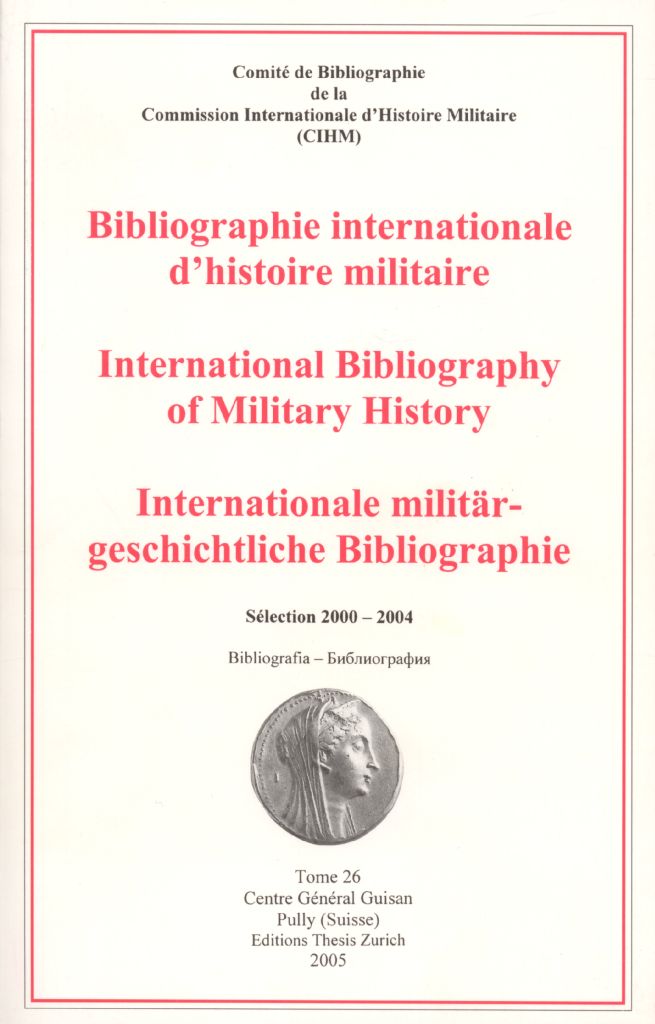« La petite guerre au xviiie siècle en Europe : une mise au point bibliographique »
Résumé de l’article en français au bas de la présente page // Abstract of the article in English below
Article publié dans :
Bibliographie Internationale d’Histoire Militaire, t. 26, Centre général Guisan, Pully (Suisse / Switzerland), éditions Thesis Zurich, 2005, p. 177-225.
* Structure de l’article : une introduction historiographique et problématique précède une bibliographie commentée – les ouvrages et articles retenus sont commentés individuellement. L’introduction est publiée en français (p. 177-186) et en anglais (p. 187-194). La bibliographie commentée couvre les pages 195-225.
With the kind authorisation of the IBMH - International Bibliography of Military History, you will find:
The introduction to the bibliography, in English, to be read entirely in HTML format on the present website, HERE.
The introduction to the bibliography in English AND the whole commented bibliography to be read entirely in PDF format on the present Website, HERE.

Résumé introductif en français :
Cet article se veut un outil précis et fouillé à l’usage des chercheurs souhaitant approfondir le domaine de la petite guerre et des troupes légères (mise à jour, 2005).
Depuis un article d’André Martel paru dans la Revue Historique en 1971, la communauté des historiens militaires en France n’a cessé périodiquement de souligner jusqu’à nos jours – avec des approches actualisées – le renouveau de cette histoire militaire. L’intérêt pour la petite guerre s’inscrit dans ce mouvement. Il a été porté aussi par la réalité de beaucoup des conflits d’aujourd’hui, dits « conflits de basse intensité », dans lesquels la tactique des troupes légères d’autrefois, alternative à la bataille, trouve son avatar contemporain. L’article attire d’abord l’attention sur d’importantes questions de vocabulaire et de sémantique : la signification de l’expression « petite guerre » en français depuis le XVIe siècle ; la différence avec le signification de la « guérilla » ; la traduction de cette expression de « petite guerre » en allemand dès l’époque moderne ; et les différentes tentatives de traduction en anglais dans la seconde moitié du XXe siècle. Une grande part de l’article est ensuite consacrée à la généalogie de l’étude de la petite guerre à l’époque moderne (XVIe - XVIIIe siècles), en France et dans les mondes anglo-saxon et germanique. Il s’agit enfin de pointer le problème du cloisonnement des travaux, entre les périodes historiques comme d’un pays à l’autre et, donc, souvent d’une langue à l’autre.
Abstract in English:
"The Petite Guerre of the 18th Century in Europe: An Updating of the Bibliography."
This article aims to be a precise and thorough scientific tool for researchers who want to go into the subject of the petite guerre and light troops in depth (update 2005).
Since the publication of an article of André Martel in the Revue Historique in 1971, historians have regularly highlighted in France, up to the present time, the comeback of military history – with successive updated approaches. The interest for the petite guerre is part of this movement. This interest has been also favoured by the reality of many conflicts nowadays, the so called “low intensity conflicts”, in which the tactic of light troops of the olden days as an alternative to the battle finds its contemporary form. The present article deals first with the meaning of the expression “petite guerre” in the French language since the 16th century, its difference with the guerrilla warfare, its translation in German from the early modern times, and the different attempts to translate it in English during the second half of the 20th century. Second, it deals with the history of the interest of historians for the subject of the petite guerre, as far as the early modern period is concerned (16th – 18th centuries), in France and in the Anglo-Saxon and German worlds. Finally, it develops the problem (and its consequences) of the compartmentalisation of scientific works upon this subject between different historical periods as well as between researchers of different countries and languages.